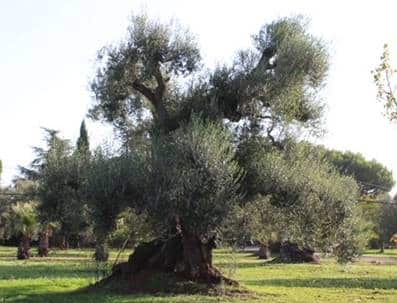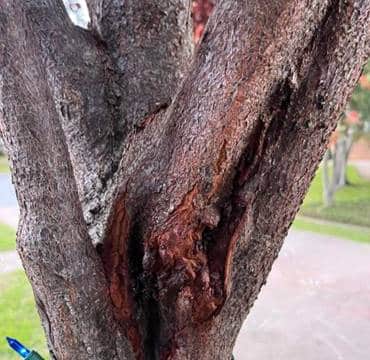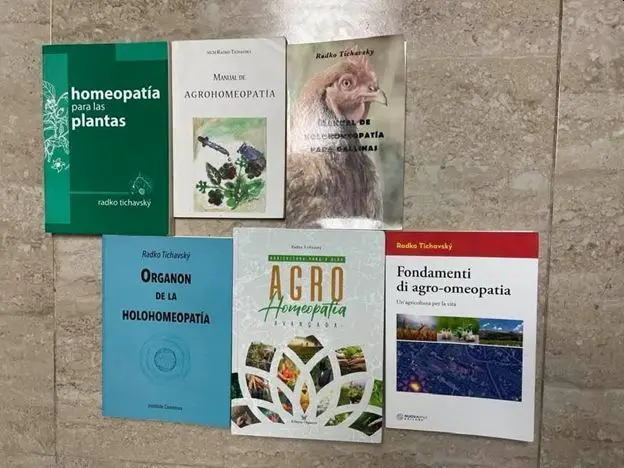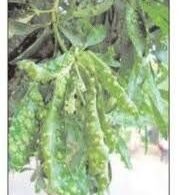Editor’s Notes:
New Video from Dr. Radko Tichavsky!
In this video, renowned Agrohomeopath Dr. Radko Tichavsky explains Holohomeopathy, the more advanced method of agrohomeopathy: https://youtu.be/GUUoO6Lt-U8 (English subtitles)
JT (Jenichen / Tichavsky) potency is often mentioned in these columns. It is a centesimal dilution followed by 500 succussions or five hundred continuous turns with a wooden stick to the right and 500 turns to the left (if handling larger volumes). The JT potency frequently has a better reaction in plants and it is very important in preparation of live bionosodes.
Dear Radko,
This is about an olive farm in Puglia, Italy. Some trees have started to be affected by Xylella, a bacteria that will dry the plants’ vessels, ultimately. killing the plant.
Some of these trees are about 600 years old, some trees in the region have reached 2000 years! All are at risk of dying, only very few types are resistant. The types are Cellina di Nardo and Ogliarola (which are the old otoctonous trees part of the DOP Collina di Brindisi, these trees get ill.) The soil is very red with lots of iron.
Monsanto has developed resistant trees and is distributing them throughout the region, but it is a pity to lose such a heritage!
Many thanks
Grace
Radko Tichavsky:
Dear Grace and Joanna,
Let me put your questions together in one answer since you are asking about the same problem. Xylella fastidiosa is a bacteria found in the xylem, and it multiplies inside the vessels, clogging them and obstructing the sap flow, which causes symptoms similar to lack of water or lack of nutrients in olive trees.
This gamma-proteobacteria is transmitted by insects, so it is important to keep sucking insects under control. For example, the presence of some native plants such as Ditrichia viscosa in the cover is the key as it attracts parasitoids of many pests in the olive tree.
A cover crop consisting only of monoculture grasses looks aesthetically pleasing, but from the point of view of protection of the olive trees it does not represent an advantage. Asparagus are usually eliminated under olive trees because they hinder fruit harvesting, but they also provide important metabolic and insect protection services to olive trees. Maintaining a vigorous biodiversity of spiders of the family Saliticidae and Thomisidae represents an important protection against sucking insects, as these two families of spiders establish their habitat in the canopy of olive trees.
The Salticidae represent protection on the leaves and the Thomisidae on the flowers. Both have excellent eyesight and resistance to hot conditions, due to a dense covering of hairs on their body. Well-meaning and “ecological” applications of kaolin can easily wipe them out, let alone applications of systemic insecticides to which they are extremely sensitive.
Xylella fastidiosa, which heads the cluster of phytoplasmas and bacteria that trigger symptoms, belongs to the gamma-proteobacteria class whose antagonistic phylum is Firmicutes. You can apply live bionosode of Aloe vera 4 JT (made from the leaves of the plant), it contains a large group of Bacillus spp. antagonists to Xylella fastidiosa, also live bionosode of Helix hedera radix 4 JT (made from the roots of the plant) is an excellent remedy because it contains Bacillus amyloliquefasciens another antagonist belonging to the phylum Firmicutes.
These homeopathic remedies establish two basic conditions for the control of Xylella fastidiosa: control of insect vectors (which will prevent reinfection) and establishment of antagonistic microbiota in the soil that can enter the vascular system of the plant and reestablish the equilibrium.
Additionally we use as a remedy Eucalyptus globosus 4 JT (made from the essential oil of Eucalyptus) sprayed on the soil and on the canopy of the trees with TM of Boswellia sacra as an adjuvant.
Dear Dr. Tichavsky,
I have been given your link by the Biodynamic association in London. I contacted them as I have a four acre olive grove in Puglia Caravigno. I recently bought it. It is on the very edge of the beautiful 5,000 acre reserve Torre Gueceto, full of ancient olive trees.
I have just read some of your advice and now understand my idea of treating the trees with what I would use to treat a person suffering from similar symptoms won’t work. The Xylella infecting a lot of the trees nearby stops the plant from absorbing water so my first thought was to treat the trees with Ayurvedic plants which act to help absorption of water.
Can you help me find the right homeopathic remedies. My little farm can be used to try out different solutions as I know many of the large farmers nearby wouldn’t even consider these solutions. I can’t just stand by and let the trees die without trying my best for them.
I am based in London and I am a working artist. I am not a farmer and I am not a homeopath but I strongly believe that your understanding and expertise is what is needed here in Italy.
Kindest of regards – Joanna Lazzarini
(THE ANSWER IS THE SAME AS TO THE PREVIOUS QUESTION ABOVE)
Dear Dr. Tichavsky,
My purple leaf plum tree (below) appears to have some sort of bacterial canker. Any ideas on how I could treat it? I live in North Central Texas, zone 8a so quite warm except for a few mild freezes usually. Zip 76039
Thank you
Celia
Radko Tichavsky:
Dear Celia,
The bacterial canker that affects all Prunus spp. is triggered by the presence of Pseudomonas syringae (gram negative bacteria belonging to the gamma-proteobacteria). You can use Cuprum metallicum 6 CH sprayed on the trunk and the aerial part of the tree.
Additionally you can apply Bionosode vivo from Aloe vera, as this plant contains in its leaves a great diversity of bacteria belonging to the phylum Firmicutes, such as Bacillus megaterium, Bacillus simplex, Bacillus subtilis. All of them are antagonists of gamma proteobacteria.
Take a leaf, wash it in tap water, cut it into pieces and liquefy it in a liter of non-chlorinated water. Then place the liter in 99 liters of non-chlorinated water along with 100 grams of sugar and make 500 turns with a wooden stick to the right and 500 turns to the left and with this liquid you water all the soil around the tree for a week until the water is finished.
Every day before watering you will make 500 turns to the left and 500 turns to the right to re-dynamize the liquid. The whole process of dynamization is done in non-chlorinated water so as not to interfere with the life of the bacteria.
Once the Aloe vera bacteria have been inoculated, they will come into contact with the root system of the tree and enter its sap, reducing the pathogenicity of Pseudomona syringae (by quorum sensing) or inhibiting it completely. The sign of progress will be the disappearance of gummosis (resin exudate on the tree trunk).
Hello Dr. Tichavsky,
Some of my outside plants have been attacked by clouds of whiteflies. They’ve been terrible on the wild ginger and now on the Chelidonium majus plants. Before I try something else, can a homeopathic remedy help me with this? How to apply?
I live in Los Angeles (Southern California). Mailing code: 90005
The summers are warm and dry. The winters are cool. The temperature varies from 48°F to 85°F and is rarely below 42°F or above 93°F.
The wet season lasts 4.3 months, from November 22 to March 30, with a greater than 10% chance of a given day being a wet day. The month with the most wet days in Los Angeles is February, with an average of 5.4 days with at least 0.04 inches of precipitation.
Thank you
Helen
Radko Tichavsky:
Dear Helen,
The appearance of the whitefly in crops can be due to several factors. If you use any fertilizer source rich in nitrogen on your plants you should avoid it, as excess nitrogen produces soft tissues in the plants, which make it easier for the whitefly to introduce its stylet (sucking apparatus) penetrating its epidermis. If you water your plants by sprinkling you should change to drip irrigation, and wet the leaves minimally.
Once you have ensured these two risk factors you can apply Calcarea carbonica 8 CH. Most people imagine that it is enough to put a few granules in the water to have an effect on the plants, but it is a mistake because we would only get a dilution of homeopathy, not a dynamization.
It is always necessary to perform the complete dynamization process. For example, you put two granules of Calcarea carbonica 6 CH in 100 ml of water and make 100 vigorous succussions, thus obtaining the potency 7 CH.
Then you put these 100 ml in 10 liters of water and make 100 turns to the right and 100 turns to the left (the turns are made continuously.) And so you get the potency 8 CH and apply the liquid on the leaves of the affected plants.
You must apply the remedy above and also below the leaves. This will harden the surface of the leaves and prevent the whitefly from penetrating the epidermis. Two applications per week for about two weeks should be sufficient to achieve an improvement.
Additionally, once a week apply Boswellia sacra 3 CH, made from common frankincense (it is actually a mixture of Myrtus communis and Boswellia sacra or B. serrata resins). Crush the incense first until it becomes a fine powder, add 30% alcohol and let it sit for a week. Then put 10 ml of the tincture in a liter of water, make 100 vigorous succussions and apply on the leaves of the plant.
The resin of Boswellia sp. and Myrtus sp. are powerful insecticides and the homeopathic emulsion will form a kind of protective layer on the surface of the leaves eliminating the possibility of hatching of whitefly eggs.
Hellos Radko,
How do I get prevent squash bugs on my summer squash plants? It’s too late this year, but for next year? I live in Moorestown N.J. ( U.S.) Zipcode 08057.
Summer High: July high is around 87 degrees
Winter Low: January low is 24
Rain: averages 47 inches of rain a year
Snow: averages 10 inches of snow a year
Thank you
Gregory
Radko Tichavsky:
Dear Gregory,
Anasa tristis (squash bug) is a nuisance in many cucurbit crops. You can see my advice from February 2022 in this same column. Additionally, you can use Melaleuca alternifolia 4 JT, made from the essential oil of the plant known as “tea tree” or Eucalyptus 4 JT, made also from the essential oil of this tree (all Eucalyptus species contain large amounts of alpha-pinene, alpha-terpinene, alpha-terpineol, potent insecticides).
Also effective is a homeopathic preparation of Lobaria pulmonaria 4 JT, a relatively common lichen, homeopathic preparation of the spider popularly called “black widow” Lactrodectus mactans 4 JT can be used as well, since in its digestive system it contains dsRNAse, enzyme that breaks down RNA from the bedbug and its microbiota. As always there are several options and you can preferably use the one found in your holon. You can do two applications per week, and then only as maintenance, one application every two weeks.
BOOKS ON HOLOHOMEOPATHY
Many readers asked about Radko Tichavsky’s books. Below is a photo of them. They are available in Spanish, Italian and Portuguese. For ordering or information: [email protected]








